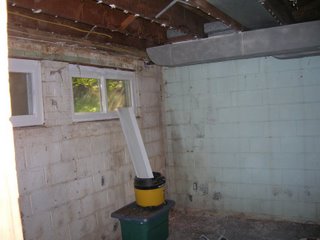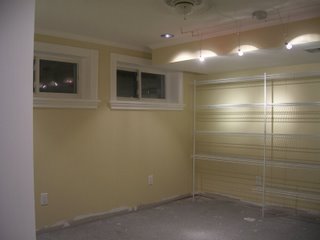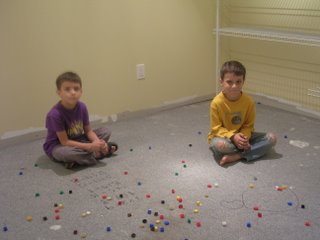Counting Blocks

With a new family living in our house (that's another blog, entirely), its a tad crowded. Which is why I've been hunkered down in the basement the past three weeks, trying to finish a bedroom so that one of the families can move down there. The sense of urgency increased as we neared Labor Day and the school year was due to start - it would have been impossible to conduct school amidst the chaos that is our home.
I nearly completed the room by Labor Day, but the carpet delivery was delayed. Anyway, here is the room.
OOPS! That's the before picture. Here is an after picture of the room, minus the new carpet.
So, until the carpet is delivered, the room is serving us very nicely as a temporary schoolroom. We can draw on the floor and everything!
So this week has been all about review. I was a little worried as the first day of school approached, and I started quizzing the boys on certain topics, like math, geography, etc. The questions would generally elicit a blank stare, followed by a twisted lip, furrowed brow, finger in mouth, inexplicable curtsy motion, and a long "ummmmmmmmm..." My fears were unfounded, however, as I was pleasantly surprised by how quickly they picked back up.
I brought a hundred lego blocks to the schoolroom today, and started out by tossing them all into the air. As they cascaded down around us, the boys looked at me as if I had lost my very last marble. But the exercise that ensued was a lot of fun.
Basically, I asked the boys - one at a time - to count the blocks for me. Josh began by stacking the blocks as he counted them. I stopped him before he could finish, and pointed out the benefits of his method. Then it was Kyle's turn. Not to be outdone, he grabbed his journal and wrote down the individual totals as he created the stacks. Beautiful.
Then I re-schmangled the blocks around randomly, and asked them to count the blocks without touching them. Of course, just as with the previous days' exercise of counting 892 hornet egg cells, they quickly got confused, lost count, and restarted numerous times. So that's when we started talking about counting methodologies.
I asked them to try a second time, thinking through what might make the job easier, and reminding them about the toothpick exercise with the egg cells. Always one to hang on a technicality, Josh ran from the room and returned with gloved hands - ha! Sorry bud, no deal. You can't touch them, even with gloves. Thinking again, he said he wanted to go get some toothpicks, but I reminded him that our entire toothpick collection was busy just now, maintaining steadfast count on 892 egg cells. Oh... yeah. Try again. He struggled for a while until I handed the reins back over to Kyle.
He went looking for a toothpick substitute, but I overruled the method and made him find another approach. He got a magic marker and began circling individual blocks, writing a "1" inside each circle. Too cute! I pointed out that the approach showed promise, but it had an obvious flaw. We expanded on it and began drawing circles around groups of 5 blocks, without writing the actual number "5" in the circles.
So we discussed the two most important principles of counting. First, you must keep track of what's been counted, and what's not been counted. As an analogy, I used an aquarium, and how the attendants must keep track of who's been fed and who's not been fed. One thing they might do, for example, is keep a journal with tank, date, time, quantity, etc. The second important principle is not losing your count. A huge problem for scatter-brained individuals like myself.
So, as another method, I showed them how we could group the blocks into smaller sets, by color, and use the journal to record the number of blocks by color. This would provide a solution to both counting principles. As an added bonus, they had to do it in Spanish - mwahahahaha.
Again they got confused, so we discussed how we needed to apply the "keeping track" principle to the smaller sets as well. We accomplished this by starting in the same area of the room for each counting pass, and walking across the room in the same direction - that way, we knew that whatever was behind us was already counted.
Using this method, we each counted the blocks separately - resulting in three counts, two different results. That's when I launched into a lecture about the importance of checks and controls for consistent results.
And that, of course, is when I lost them.
0 Comments
Post a Comment